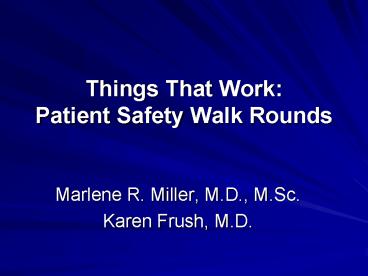Things That Work: Patient Safety Walk Rounds - PowerPoint PPT Presentation
1 / 26
Title:
Things That Work: Patient Safety Walk Rounds
Description:
Worked with JHH, pulled needle from CC, substituted new safety needle, no further problems ... Approximately 40 events in past year. Unnecessary exposure to radiation ... – PowerPoint PPT presentation
Number of Views:413
Avg rating:3.0/5.0
Title: Things That Work: Patient Safety Walk Rounds
1
Things That WorkPatient Safety Walk Rounds
- Marlene R. Miller, M.D., M.Sc.
- Karen Frush, M.D.
2
Safety Walk Rounds
- Organizations improve upon safety only when
leaders are visibly committed to change, when
they enable staff to openly share safety
information, and when staff feel that their
comments are heard and acted upon. When an
organization does not have such a culture, staff
members are often unwilling to report adverse
events and unsafe conditions because they fear
reprisal or believe reporting wont result in
change. www.ihi.org
3
The Hopkins Experience
4
Childrens Center Safety Rounds
- Every Wednesday 1000 AM (since 2003)
- Every Tuesday 1000 AM (since 12/2004)
- Covers all Childrens Center units and outpatient
clinics and Emergency Dept and Pediatric Pharmacy - C9, 8W, PICU, RR, C6, C4, 3E, PCRU, NICU, Peds
ED, HLPC, Pharmacy, JHOC Specialty Clinics - Senior Leaders (Chairman, Chief of Surgery, Board
of Trustees) - Focus on proactive safety concerns
5
Scope Impact of Safety Rounds
- Total issues/projects 145
- Active issues/projects 43
- Completed issues/projects 102
- Each unit/clinic has 3-5 active issues/projects
- At first, much low hanging fruit issues are
more complex now - Units now keep lists and wait for us
- ¾ of units had Safety Climate scores gt60
6
next patient will be harmed by 4 vials
7
New Products
8
(No Transcript)
9
Zofran/Anzemet
- JHH therapeutic interchange made Anzemet first
drug of choice for nausea - It is not uncommon for patient to not respond to
Anzemet and need Zofran - Zofran needed to specially come up from Pharmacy
- WHAT ABOUT THE RECOVERY ROOM?
- Worked with PT Committee to place Zofran in all
Recovery Rooms
10
(No Transcript)
11
Safer Outpatient Prescribing
- No requirement to record a weight on pediatric
prescriptions - Without a weight, an external pharmacy that
wanted to dose check was powerless - Revamped all ambulatory prescription pads to
include a line for recording weight - Required that JHH Pharmacies perform a
weight-based dose check before dispensing
12
Safety Needles.safer for whom?
- Entire hospital changed to safety needles
- HLPC found over several months that 8 25G
needles had no holes bored - (HLPC does gt150 immunizations a week)
- Worked with JHH, pulled needle from CC,
substituted new safety needle, no further problems
13
(No Transcript)
14
The Duke Experience
15
Tools to Improve the Culture of Safety
- Voluntary Reporting System
- Non-punitive reporting policy
- Team training Crew Resource Management
- Unit based safety teams
- Safety walk rounds
16
Goals of Safety Walk Rounds
- Identify procedures or processes that could put
patients at risk - Identify opportunities to improve care and reduce
risk - Close the gap between leadership and frontline
perspectives on safety - Allow executives opportunities to model safety as
a priority, provide appropriate resources to
improve care
17
Safety Walk Rounds
- Initiated in Childrens Hospital January 2004
- Included all areas caring for children
- Intermediate care, ICN, PICU, BMT, FTN, ED,
Psychiatry, Radiology, CHC (outpatient) - Improvement in hospital safety survey noted by
October 2004 - Expanded to Duke University Hospital January 2005
18
Identifying Problems Whats the Next Thing To
Harm a Patient?
- Medication safety
- PICU - expired syringes
- PBMT late medication delivery
- Home Health pump labeling
19
Identifying Problems Whats the Next Thing To
Harm a Patient?Medication Safety
20
Identifying Problems Whats the Next Thing To
Harm a Patient?
- Environment of care
- Patient security
- Unrestricted access
- Hazardous environments
21
Identifying Problems Whats the Next Thing To
Harm a Patient?Environment of Care
22
Identifying Problems Whats the Next Thing To
Harm a Patient?
- Patient identification
- ID bands
- Name changes
23
Solving Problems Patient Name Changes
- Safety risk name changes in patients, especially
from ICN, lead to incorrect radiographic
study/procedure performed - Approximately 40 events in past year
- Unnecessary exposure to radiation
- Potential risk of complications associated with
unnecessary procedure - Initial interventions
- Limited in scope (Peds Radiology and ICN)
- Policy and procedure focused errors still
occurring - The problem is unsolvable
24
Impact of Safety Walk Rounds
- Concern raised during walk rounds with Chief
Patient Safety Officer and hospital executives - Other departments experienced similar issues
- RCA gt 3000 potential entry points to change name
- Required IT, Medical Record solution
25
The Solution
- Employees with ability to change patient names
reduced from 3000 to 10 - Patient data computer system does not allow
unauthorized employees to change names provides
a true hardwired system solution - Education for staff, patients, families included
in process - Ongoing monitoring and control
- Medical Records performs audits of all name
changes - All inpatient name changes are reviewed by
Childrens Safety/Quality Core Team
26
Next Steps
- Expansion to Health System level
- Academic medical center
- Community hospital
- Clinics
- Incorporation of patients and families
- Youre the generalist, Im the specialist































